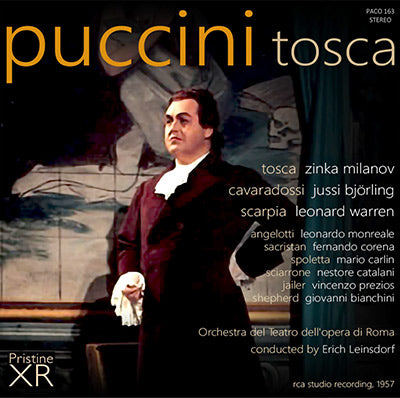
This album is included in the following sets:
This set contains the following albums:
- Producer's Note
- Full Track Listing
- Cover Art
While the 1953 Callas/di Stefano/Gobbi Tosca (available on PACO080) is justifiably famous, opera lovers in the 1950s could choose between an embarrassment of riches in this opera. Instead of Callas there was Tebaldi or Milanov; instead of di Stefano there was Björling or del Monaco; and instead of Gobbi there was London or Warren. All of these recordings featured great singers and it is right to revisit one of these less well-known Toscas.
Those us who never heard Jussi Björling sing in person depend on his surviving recordings. Some of his most notable roles are only preserved in live broadcasts (Romeo, Riccardo, Faust, Don Carlo), some only in studio recordings (Radames, Canio) and a few in both formats (Manrico, Des Grieux, Rodolfo). His Cavaradossi, like his Turridu, is preserved in a studio recording but otherwise only in ‘in-house’ tapes instead of broadcasts. Despite sixteen performances of the role at the Metropolitan Opera, Björling was never granted a broadcast performance. We are fortunate that in 1957 RCA decided to record Tosca with three principals who had sung these roles together on the Met’s stage the previous year, and captured Björling’s voice in stereo in a complete opera for the first time.
Björling easily ranks as one of the best tenors to assume the role of Cavaradossi. His musicality brings us an effortless legato and an immaculate Italianate style. While he can, and does, thrill in the vocal climaxes, he is never overly melodramatic and his soft singing in Act 3 is particularly lovely. As one critic put it, ‘he sang it as music and not as a display for pyrotechnics.’
Zinka Milanov’s lengthy Met career stretched back to 1937 but Tosca was a comparatively late addition her Met roles. Although she had sung the role elsewhere she did not perform it in New York until 1955, and then only as a last minute substitute for Renata Tebaldi. What Milanov brings to the part is her natural personification of the diva – little acting required! Critics also valued her dramatic soprano in a role that can overwhelm some lighter-voiced singers. Milanov brought all the ‘vocal power and passion’ required but was also able to offer ‘soft tones that seemed to come from the flies of the stage rather than her throat.’
Another comparative late-comer to this opera in Leonard Warren, who made his debut in the role of Scarpia in December 1955. Already an accomplished principal baritone, particularly in Verdi roles, Warren brings an excellent dramatic intensity as well as the security of tone and vocal shading so typical of his singing.
Erich Leinsdorf was something of an unusual choice to conduct this opera. Having been in charge of the Met’s German wing between 1938 and 1943 Leinsdorf spent much of the following decade concentrating on orchestral conducting. In the summer of 1957, however, RCA arranged for him to record Lucia di Lammermoor, Madama Butterfly, and Tosca, all in Rome. The last two were recorded simultaneously providing plenty of rest days for the cast. Anna-Lisa Björling candidly admits in her biography of her husband that Jussi Björling spent most of those rest days in the bar but there is happily no evidence that this disrupted the recording of Tosca.
PUCCINI Tosca
DISC ONE
ACT ONE
1. Ah! Finalmente! (5:28)
2. Dammi i colori - Recondita armonia (4:42)
3. Gente là dentro! (1:07)
4. Mario! Mario! Mario! (7:38)
5. Ah, quegli occhi - Quale occhio al mondo può star di paro (5:44)
6. È buona la mia Tosca (5:23)
7. Un tal baccano in chiesa! (3:38)
8. Tutto è chiaro (3:27)
9. Ed io venivo a lui tutta dogliosa (4:11)
10. Tre sbirri, una carrozza (4:11)
DISC TWO
ACT TWO
1. Tosca è un buon falco! (2:51)
2. Ha più forte (2:26)
3. Meno male! (3:17)
4. Dov'è dunque Angelotti? (2:13)
5. Ed or fra noi parliam da buoni amici (4:02)
6. Orsù, Tosca, parlate (3:14)
7. Basta, Roberti (1:37)
8. Nel pozzo, Del giardino (4:19)
9. Se la giurata fede debbo tradir (3:59)
10. Vissi d'arte (3:13)
11. Vedi, le man giunte io stendo a te! (3:32)
12. E qual via scegliete? (5:53)
ACT THREE
13. Io de' sospiri (4:58)
14. Mario Cavaradossi? A voi (3:22)
15. E lucevan le stelle (4:37)
16. Ah! Franchigia a Floria Tosca (2:40)
17. O dolci mani mansuete e pure (5:41)
18. E non giungono (2:46)
19. Com'è lunga l'attesa! (2:02)
20. Presto! Su, Mario! Mario! Su! Presto! Andiam! (1:18)
CAST
Floria Tosca, a celebrated singer - Zinka Milanov
Mario Cavaradossi, a painter - Jussi Björling
Baron Scarpia, chief of police - Leonard Warren
Cesare Angelotti, escaped prisoner - Leonardo Monreale
The Sacristan - Fernando Corena
Spoletta, police agent - Mario Carlin
Sciarrone, police agent - Nestore Catalani
A Jailer - Vincenzo Preziosa
A Shepherd Boy - Giovanni BianchinI
Rome Opera House Orchestra and Chorus
Giuseppe Conca, chorus master
conducted by Erich Leinsdorf
XR remastering by Andrew Rose
Cover artwork based on a photograph of Jussi Björling as Cavaradossi in 1956
Recorded 2, 4, 6, 8, 10, 14, 18 July 1957, Rome Opera House
First issued as RCA Victor LM-6052 (mono) and LSC-6052 (stereo)
Total duration: 1hr 53:29

